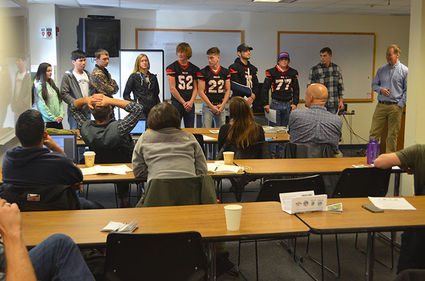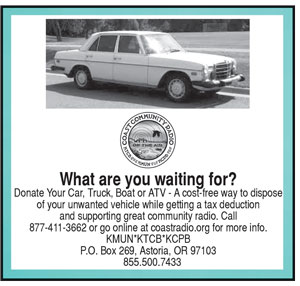WHS science students work with partners
November 9, 2017

Diana Zimmerman
Wahkiakum High School science teacher Jeff Rooklidge and students visited the Coastal Marine Resource Committee Summit on Friday to share what they've been learning in the field.
Wahkiakum High School science teacher Jeff Rooklidge and a group of his students visited the 7th Annual Coastal Marine Resource Committee Summit, which was being held in Cathlamet last week.
Rooklidge, with a little help from some of his students, gave an overview of some of the educational opportunities he has been able to offer in the last five years.
He realized that the kids were more engaged when they got out in the field, so he began trying to find partnerships, and new ways to make that happen. First he approached his superintendent for what he described as a "junky, old vehicle to load up the kids" so they could begin to focus on field and wildlife biology.
Rooklidge then went to the biologists at the Julia Butler Hansen Refuge for the Columbian White-tailed Deer. They started a wood duck nest box program and students picked up some science while they learned about native species.
He visited two local hatcheries and talked to timber companies. Through those partnerships, students learned about riparian zones and the science behind growing trees, as well as fish management practices and aquaculture.
"We learned a lot about the anatomy of the fish," WHS student Gage Horman said of their visits to the hatchery. "We learned about their life cycles. We got to do a lot of hands on activities. Every day we got to go out, we were working with the fish, we were out in the raceways. We got to collect eggs from coho salmon and fertilize them before putting them in incubation pens. It was a fun learning experience."

Rooklidge had purchased chest waders for his class, but three years later, the kids were getting soaked.
"There were holes all over the chest waders," he said. "I was telling the students to toughen up in December. The worst part was that the waders had been worn every day for three years straight and they were ripe with odor. It was awful."
That's when he was approached by the Wahkiakum MRC, specifically Carrie Backman, Donna Westlind, and Paula Culbertson, who wanted to help the kids, support their education, and buy them some equipment.
"There was a celebration in my room when we got that new package of chest waders from Cabelas," Rooklidge said, "so it was pretty fun. It's been an amazing partnership and I feel really blessed by how they'e helped us expand some of our opportunities."
Other activities:
A grant allowed students to "live a day in the life of a marine biologist." Rooklidge took a group to the Oregon State University Marine Science Center in Newport, Ore. The students got to go out with one of their researchers to conduct a mud shrimp and ghost shrimp survey. Students went back to the lab and learned about taxonomic keys, marine food chains, food webs, the aquatic ecological system, the importance of shrimp and aquatic invertebrates, and how to use calipers to measure different species. The students then toured the aquarium, and learned about the research they were doing at OSU.
Students have visited the Marine and Environmental Research and Training Station at Clatsop Community College in Astoria, to learn about opportunities and careers in marine sciences. According to Rooklidge, the students get to board some of the boats, learn about what it takes to get a license and work as a captain on a boat, learn about navigation procedures, and take tours on some of the training vessels.
Students have gone to the Maritime Museum in Astoria, where they were challenged to consider how estuaries affect communities, the people, and the economy, historically and culturally.
Rooklidge also approached a local conservation district to form a partnership.
"We plant trees along local rivers and streams and areas to prevent soil erosion and prevent knotweed from growing back," WHS senior Casey Wilson said. "They go out and destroy all the knotweed and we go in and plant the trees to prevent the soil from eroding into the river and affecting fish habitat."
"We are targeting areas where they have placed engineering logjams in there because the river has maybe too much velocity and is eroding a lot of the banks," Rooklidge said. "What is really fun is we were able to go snorkeling in there to see how many of the juvenile fish were really utilizing the root wads and the large woody debris for habitat. We are working with the conservation district to follow up as well. We measure elk browse and how the trees are surviving and all that. We've planted 5,000 trees, I think, in the last four years, and having a great time learning about riparian zones and just the whole interrelationship between the trees providing shade and cover and helping benefit the food chains and the stream."

A grant has allowed kids to go on Lewis and Clark field trips.
"The past two years I've gotten to go on this field trip," Wilson said, "where we got to live a day in the life of Lewis and Clark. We kayaked down the Columbia River, taking their route, and stopped at some of the places where they were believed to have stopped. We drew pictures, like they did, of local plant and animal life."
Students also visited some of the man made dredge spoils, Wilson said, and saw how that had affected and changed the environment.
"The focus of that grant was to challenge the kids to think about how is the river different than when Lewis and Clark came through, and how those changes affect the ecosystem and wildlife," Rooklidge said.
Students have done surveys of Cormorants and Caspian Terns on Fitzpatrick Island, located across from Skamokawa, reporting what they find to the ebird.org site run by the Cornell Lab of Ornithology.
They are learning about geology along the Columbia riverbank. One student field trip involves a stop about a mile upriver from the Astoria-Megler bridge, where they read a journal entry from Lewis and Clark. The journal entry describes the spot, and talks about how Lewis and Clark struggled to keep their canoes afloat and couldn't find a safe place to camp because of huge old growth logs.
Students discuss why waves from the ocean were crashing at the location. They discuss how the jetty and dams have affected the flow energy, and how the alterations on the Columbia have altered the ecosystem.

Rooklidge is teaching students how to conduct habitat assessments in his environmental science classes.
"We check water flow around streams in Wahkiakum County," WHS senior Zach Brown said. "It's a fun experience to go out there and see the fish, see where all the reds are, where the spawning eggs are too."
According to Rooklidge, students are measuring discharge, dissolved oxygen, pH, temperature, turbidity, and conducting macro-invertebrate surveys, snorkel surveys, spawning ground surveys, vegetation surveys, and more.
A grant for a snorkel survey a couple years ago allowed Rooklidge and a couple students to go to the Abernathy Fish Technology Center, and learn how to survey with snorkel techniques with a couple of their habitat biologists.
Rooklidge has been teaching his students how to do snorkel surveys ever since.
"They are learning about fish morphology and different species of salmon," he said. "They have a blast with that, especially getting in snorkel suits, and learning a ton."
Finally, students have gotten involved in a Columbia River Estuary Science Education Outreach Program. The program is organized by the Washington State University-Vancouver campus. It involves five schools located near the Columbia River, including Wahkiakum, Ilwaco, Kelso, Vancouver, and Washougal.
"They're using high school students to collect and gather the data," Rooklidge said. "We're working with a modeler out of WSU, who is trying to take all these components and make predictions, especially about invasive zoo plankton and how nutrient levels are affecting their communities. We are measuring phosphates and nitrates. They are hypothesizing that the closer we get to the estuary, that the concentrations will build up. The focus of the study is, does that alter the plankton communities and lead to harmful algal blooms?"
"I'm appreciative for the opportunity to get my students out in the field," Rooklidge said. "I want to thank the MRC for helping me and providing these opportunities for the kids."
According to Rooklidge, two of his former students have degrees in forestry. One student is at Brown University majoring in environmental science, another student is at WSU studying environmental science. A former student is studying wildlife biology at Evergreen, and two are studying marine biology, one at UW, and the other at Western Washington University.
"They are great kids," Rooklidge said. "They work really hard and they are super motivated. Giving them opportunities to do authentic real life science out in the field, really makes a difference for them. There is no more greater satisfaction for me as a teacher than supporting these kids."







Reader Comments(0)